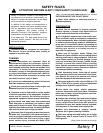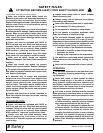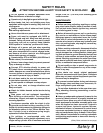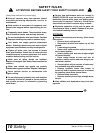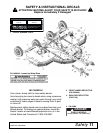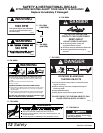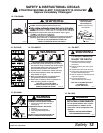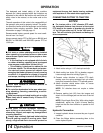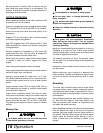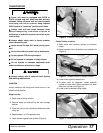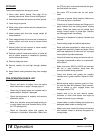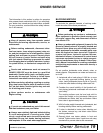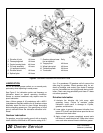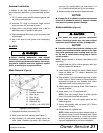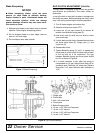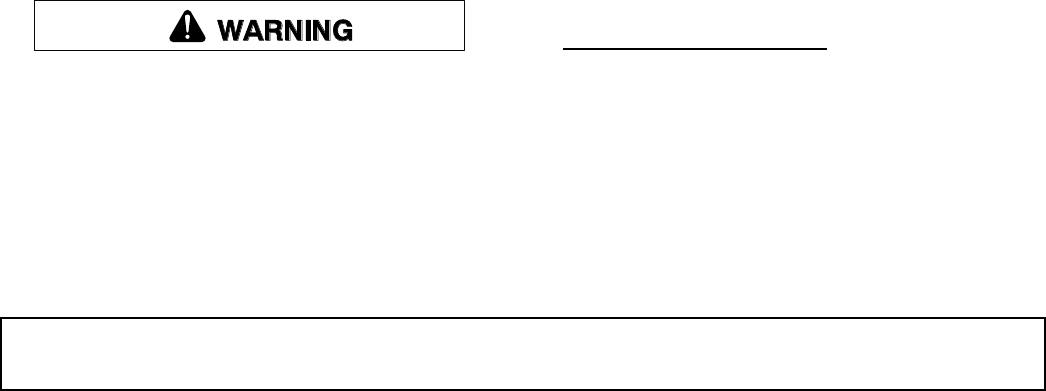
Operation 15
MAN0707 (5/30/2008)
3. Route the hose through the hose holder at the
hitch and be sure the hose can slide freely in the
holder. Do not allow hose slack to drag on the
ground or become caught on tractor protrusions.
4. Attach the hydraulic hose to the tractor.
5. From the operator position, start tractor and raise
and lower deck several times to purge trapped air
from the hydraulic cylinder.
Interference Check
1. Be sure that tractor 3-point lift links do not interfere
with hydraulic hoses, cutter driveline, or cutter
frame.
2. Check for straight-ahead operation and at full
turning angles. If there is any interference, remove
the lower lift links.
3. Contact between tractor lift links and cutter parts
can cause damage, especially when turning.
CV Driveline Turning Limits
NOTICE
■ You must not exceed a turning angle of 80
degrees at the head of the Constant Velocity drive-
line or damage will occur.
1. To check for potential excessive turn angle,
disconnect the driveline from tractor.
2. Start engine and turn as far right or left as possible.
3. Shut engine off and try to connect CV driveline to
tractor. If it cannot be connected, the turn angle is
too severe.
4. Restart engine and straighten angle slightly, shut
off engine and try to connect CV driveline to tractor.
5. Repeat the process until the driveline can be
connected. The point at which the driveline can be
connected is the maximum turn that should be
made.
Cutting Height Adjustment
On pull-type or semi-mounted units with
optional hydraulic cutting height adjustment, use a
single-acting cylinder with a maximum extended
length of 28-1/4" (718 mm) from attaching point
center to center.
NOTICE
■ Avoid ground contact with blades. Striking
ground with blades produces one of the most dam-
aging shock loads a cutter can encounter. If this
occurs repeatedly, the cutter, driveline, and gear-
boxes will be damaged.
Cutting height range is from 1" to 15". A hydraulic cylin-
der or ratchet jack is available for cutting height adjust-
ment.
When selecting a cutting height, you should consider
the area of operation. If the ground is rolling and has
mounds the blades could contact, set the cutting height
accordingly. The cutting height (blade edge) is approxi-
mately 1" above the bottom of the side skid.
Cutting Height (Normal Mowing) - Center Section
1. Position the cutter on a hard level surface and
select an approximate cutting height, Example 6".
2. Raise wings and lock them in the UP position.
3. Use any of the optional cutting height mechanisms
to raise or lower the center section to obtain a
distance of 5" from bottom edge of skid shoe to the
ground.
4. Loosen jam nuts on the attitude rod that runs from
the wheel yoke to the tongue.
5. Adjust rod in or out until the rear of the cutter is
approximately 1/2" higher than the front.
6. Tighten jam nuts against sleeve.
Cutting Height (Normal Mowing) - Wings
1. Lower wings to normal mowing position.
2. Loosen the jam nut on the adjustable link (turn
buckle).
3. Lengthening the link will raise the wing, shortening
the link will lower the wing. The rear edge of the
wing should be parallel to the ground.
When using the cutter to shred, the rear of the cutter
deck should be approximately 1/2" to 1" lower than the
front.
NOTE: Equal Angle Drive Only: With the cutting height
established, adjust the driveline carrier bearing in the
H-frame to ensure the front driveline is parallel to the
ground with cutter in cutting position.
TRACTOR OPERATION
Use care when operating around tree limbs and other
low objects. Avoid being knocked off tractor and being
injured.
Only use a tractor with a Roll Over Protection Structure
(ROPS) and seat belt. Securely fasten seat belt.
The cutter is operated with tractor controls. Engage the
PTO at a low rpm to prevent excessive loads on the
cutter drive system. Increase throttle to recommended
PTO operating RPM.



